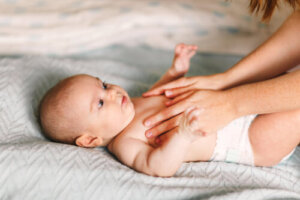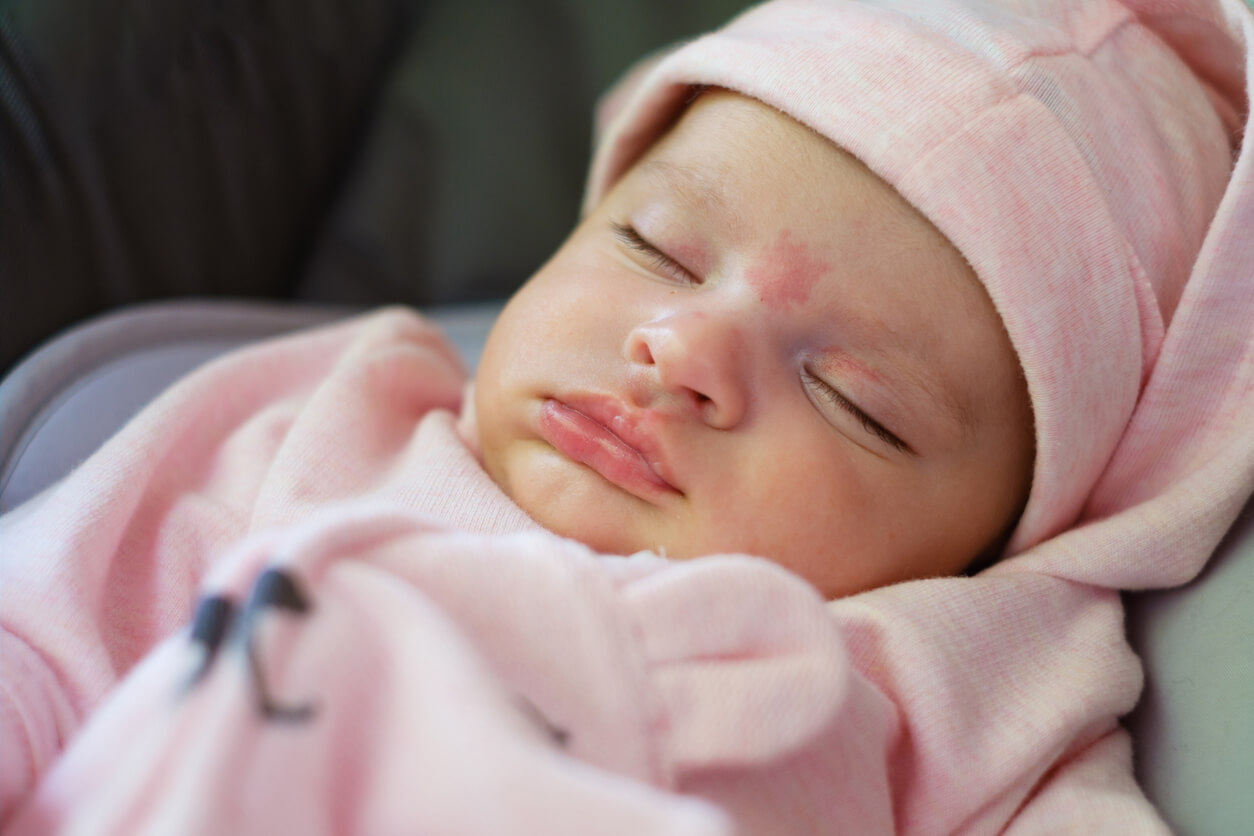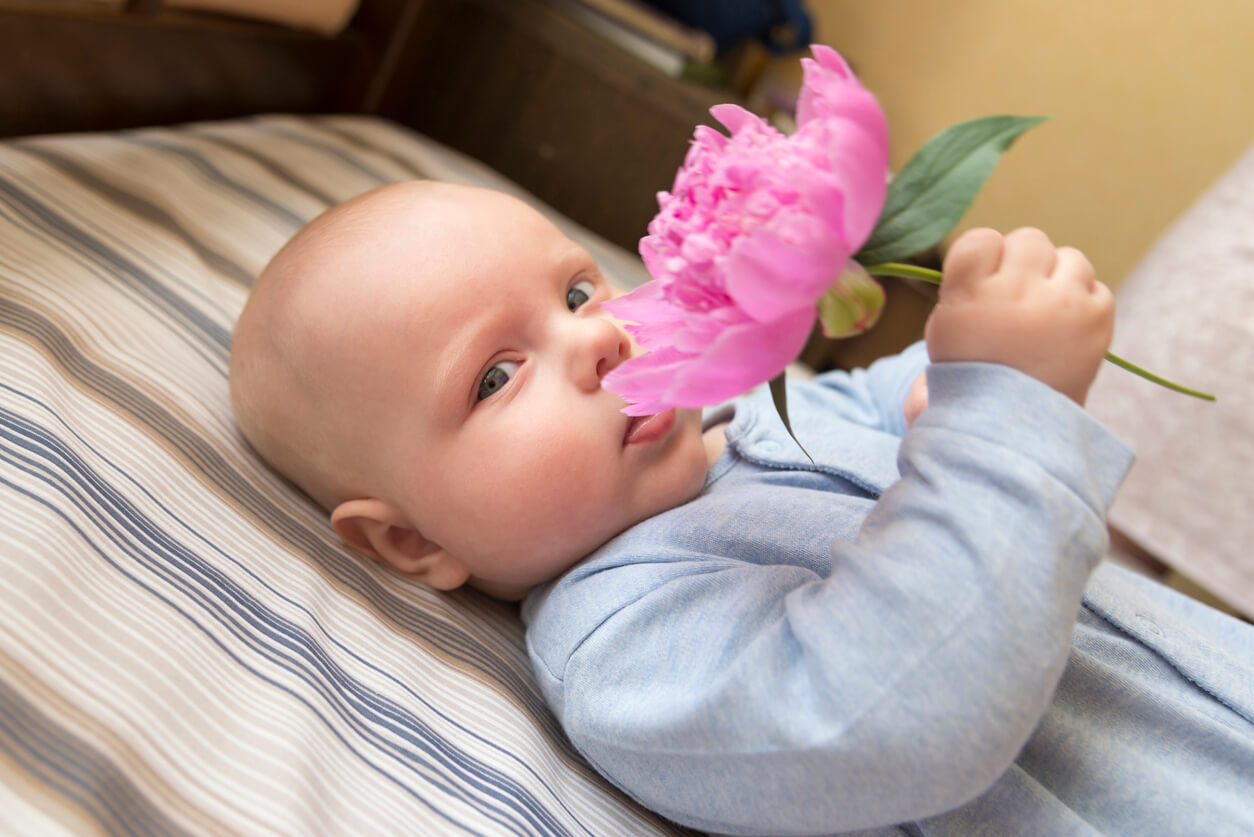10 Curiosities About the Skin of Babies


Written and verified by the dermatologist Maria del Carmen Hernandez
In addition to being very soft, the skin of babies is their shield against the aggressive factors of the outside world. Likewise, knowing and caring for it, along with interacting with all their senses, promotes healthy development and further nurtures the emotional bond between mom and baby.
Curiosities about the skin of babies
Surely, when you hold your baby in your arms, you don’t think about these things, but there are several curiosities about their skin that may surprise you. Here are ten of the most striking facts about the skin of babies.
1. Cold feet and hands
Newborns often have cold feet and hands. This is because they don’t yet have the ability to regulate their temperature correctly and their circulatory system hasn’t yet fully matured.
At this stage, priority is given to the distribution of blood to the vital organs, so the distal parts, such as the extremities, remain cold.
2. Birthmarks
About 1 in 3 babies have some variety of birthmark. The most common are the salmon-colored spots, which are called stork bites when they appear on the nape of the neck, and angel’s kisses when they appear on the forehead.
According to a study in Actas dermo-sifiliográficas, salmon spots appears in more than 80% of babies.

3. Hair all over the body
Newborns have hair all over their bodies, on the back, face, legs, arms, and even ears. This is called lanugo and is what provides protection inside the womb. Most of the time, they lose it before birth, digest it, and it becomes part of the meconium.
Other infants are born with this hair, which will slowly and gradually fall off.
Read also: My Baby Has Reactive Skin
4. Active mammary glands
Some newborns may produce milk as a result of stimulation by maternal hormones. In some cases, pediatricians may advise light pressure to drain the contents to prevent pain in the region and the formation of fatty cysts.
5. Babies don’t sweat
Sweating is one of the ways our body uses to regulate body temperature, especially in hot weather or during physical exercise.
Although the sweat glands of newborns are normal, they’re not very effective in fulfilling their function. For this reason, it’s essential to protect them from heat and cold, as they’re very sensitive.
6. Hair growth
Some babies are born bald and others with a lot of hair. This is because the amount of hair they’re born with depends on how much hair their parents have, i.e. their genetic background.
In most cases, dark hair is more evident, and light hair may be less visible and is also thinner. Likewise, the hair babies have at birth is not their definitive hair.
7. The skin of babies is different from that of their parents
The skin of newborns is different from that of an adult. While it may look perfect, it’s sensitive and requires specific protection and care during the first 12 months.
In fact, some of the aspects that differentiate it from older skin, according to Pharmaceutics, include the following:
- It dries more easily
- Although it absorbs more moisture, it also loses it more quickly
- It’s more prone to irritation and allergies
- It’s 30% thinner
You may be interested in: Angel Kisses and Stork Bites: Spots on Baby’s Skin

8. Hygiene stimulates their senses
Whether you clean your newborn’s skin or apply a moisturizing emulsion, you’re not only taking care of their delicate skin. These daily routines can stimulate several senses, such as touch and smell.
Combining loving touch with pleasant fragrances creates memories that will last a lifetime. In fact, smell is the most powerful sense in babies, who recognize their mother by her scent.
9. Babies’ skin has memory
The skin is characterized by having memory and accumulating the damage suffered since childhood, which is why it’s so important to take into account and implement all the necessary precautions to protect it.
In turn, it works as a barrier to prevent the invasion of germs and water loss, while providing protection against temperature changes. It also blocks ultraviolet rays that can be harmful.
10. Harlequin phenomenon
This phenomenon occurs frequently in premature infants in the first weeks of life. It consists of the fact that, when the baby is placed on its side, the half of the body that rests on its side takes on an intense red color, while the other side remains pale. This phenomenon is benign and goes away after a few minutes when the baby is placed on its back.
The temporary skin of babies
Babies, physiologically, have an immaturity in their regulatory systems of blood flow to the skin. This temporary circumstance is the cause of some striking curiosities.
However, although they may cause alarm and concern in parents, it should be noted that they’re benign and transitory processes of newborns.
In addition to being very soft, the skin of babies is their shield against the aggressive factors of the outside world. Likewise, knowing and caring for it, along with interacting with all their senses, promotes healthy development and further nurtures the emotional bond between mom and baby.
Curiosities about the skin of babies
Surely, when you hold your baby in your arms, you don’t think about these things, but there are several curiosities about their skin that may surprise you. Here are ten of the most striking facts about the skin of babies.
1. Cold feet and hands
Newborns often have cold feet and hands. This is because they don’t yet have the ability to regulate their temperature correctly and their circulatory system hasn’t yet fully matured.
At this stage, priority is given to the distribution of blood to the vital organs, so the distal parts, such as the extremities, remain cold.
2. Birthmarks
About 1 in 3 babies have some variety of birthmark. The most common are the salmon-colored spots, which are called stork bites when they appear on the nape of the neck, and angel’s kisses when they appear on the forehead.
According to a study in Actas dermo-sifiliográficas, salmon spots appears in more than 80% of babies.

3. Hair all over the body
Newborns have hair all over their bodies, on the back, face, legs, arms, and even ears. This is called lanugo and is what provides protection inside the womb. Most of the time, they lose it before birth, digest it, and it becomes part of the meconium.
Other infants are born with this hair, which will slowly and gradually fall off.
Read also: My Baby Has Reactive Skin
4. Active mammary glands
Some newborns may produce milk as a result of stimulation by maternal hormones. In some cases, pediatricians may advise light pressure to drain the contents to prevent pain in the region and the formation of fatty cysts.
5. Babies don’t sweat
Sweating is one of the ways our body uses to regulate body temperature, especially in hot weather or during physical exercise.
Although the sweat glands of newborns are normal, they’re not very effective in fulfilling their function. For this reason, it’s essential to protect them from heat and cold, as they’re very sensitive.
6. Hair growth
Some babies are born bald and others with a lot of hair. This is because the amount of hair they’re born with depends on how much hair their parents have, i.e. their genetic background.
In most cases, dark hair is more evident, and light hair may be less visible and is also thinner. Likewise, the hair babies have at birth is not their definitive hair.
7. The skin of babies is different from that of their parents
The skin of newborns is different from that of an adult. While it may look perfect, it’s sensitive and requires specific protection and care during the first 12 months.
In fact, some of the aspects that differentiate it from older skin, according to Pharmaceutics, include the following:
- It dries more easily
- Although it absorbs more moisture, it also loses it more quickly
- It’s more prone to irritation and allergies
- It’s 30% thinner
You may be interested in: Angel Kisses and Stork Bites: Spots on Baby’s Skin

8. Hygiene stimulates their senses
Whether you clean your newborn’s skin or apply a moisturizing emulsion, you’re not only taking care of their delicate skin. These daily routines can stimulate several senses, such as touch and smell.
Combining loving touch with pleasant fragrances creates memories that will last a lifetime. In fact, smell is the most powerful sense in babies, who recognize their mother by her scent.
9. Babies’ skin has memory
The skin is characterized by having memory and accumulating the damage suffered since childhood, which is why it’s so important to take into account and implement all the necessary precautions to protect it.
In turn, it works as a barrier to prevent the invasion of germs and water loss, while providing protection against temperature changes. It also blocks ultraviolet rays that can be harmful.
10. Harlequin phenomenon
This phenomenon occurs frequently in premature infants in the first weeks of life. It consists of the fact that, when the baby is placed on its side, the half of the body that rests on its side takes on an intense red color, while the other side remains pale. This phenomenon is benign and goes away after a few minutes when the baby is placed on its back.
The temporary skin of babies
Babies, physiologically, have an immaturity in their regulatory systems of blood flow to the skin. This temporary circumstance is the cause of some striking curiosities.
However, although they may cause alarm and concern in parents, it should be noted that they’re benign and transitory processes of newborns.
All cited sources were thoroughly reviewed by our team to ensure their quality, reliability, currency, and validity. The bibliography of this article was considered reliable and of academic or scientific accuracy.
- Mack MC, Tierney NK, Ruvolo E Jr, Stamatas GN, Martin KM, Kollias N. Development of solar UVR-related pigmentation begins as early as the first summer of life. J Invest Dermatol. 2010 Sep;130(9):2335-8. doi: 10.1038/jid.2010.104. Epub 2010 Apr 29. Erratum in: J Invest Dermatol. 2011 Jun;131(6):1388. Ruvolo, Edvardo Jr [corrected to Ruvolo, Eduardo Jr]. PMID: 20428184.
- Monteagudo B, Labandeira J, Acevedo A, Cabanillas M, León-Muiños E, Fernández-Prieto R, Toribio J. Mancha salmón: estudio descriptivo [Salmon patch: a descriptive study]. Actas Dermosifiliogr. 2011 Jan;102(1):24-7. Spanish. doi: 10.1016/j.ad.2010.06.019. Epub 2010 Dec 22. PMID: 21315858.
- Verhave BL, Nassereddin A, Lappin SL. Embryology, Lanugo. 2021 Oct 18. In: StatPearls [Internet]. Treasure Island (FL): StatPearls Publishing; 2022 Jan–. PMID: 30252348.
- Rahma A, Lane ME. Skin Barrier Function in Infants: Update and Outlook. Pharmaceutics. 2022 Feb 17;14(2):433. doi: 10.3390/pharmaceutics14020433. PMID: 35214165; PMCID: PMC8880311.
This text is provided for informational purposes only and does not replace consultation with a professional. If in doubt, consult your specialist.








